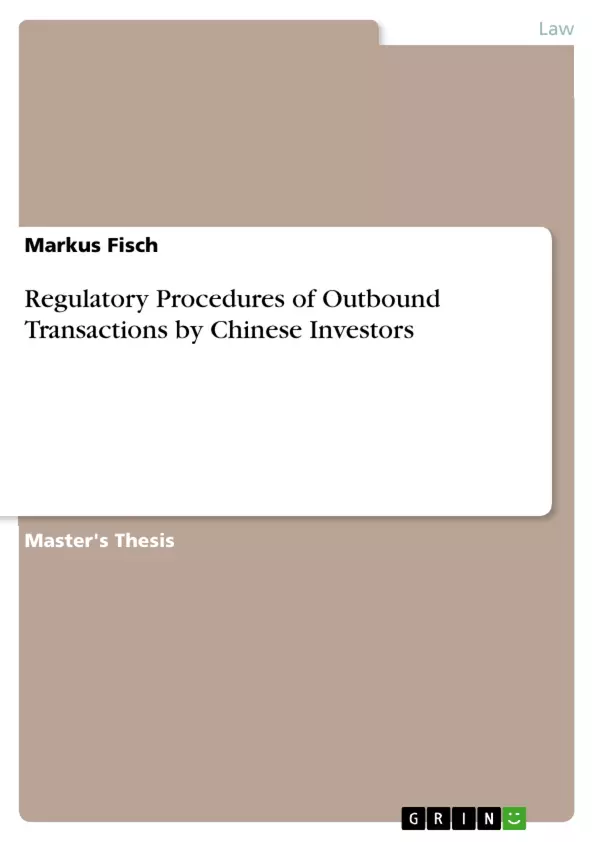Together with the economic rise of China in recent years and its new role of a leading economic power in the world, the investment activities of Chinese companies abroad has gained tremendous importance and is an essential factor for international competitiveness. But the performance of outbound direct investments underlies an unique regulatory system according to Chinese law which is characterized by a wide range of legal provisions and a variety of different authorities. This often results in disadvantages for Chinese companies in bidding procedures compared to Western competitors.
However, the Chinese government has recognized, in recent years, the increasing importance of outbound direct investments for China's economic position, and changed the regulatory system, which existed for over 30 years, in a significant way. The purpose of this thesis lies in analyzing the current regulatory system, identifying the progress noted in comparison to the former regime, elaborating the pros and cons and giving improvements for the future.
Inhaltsverzeichnis (Table of Contents)
- CHAPTER I INTRODUCTION
- CHAPTER II THE “GOING OUT” STRATEGY IN DETAIL
- 2.2.1 Cross-Border Direct Investments in Renminbi
- 2.2.2 Cross-Border Securities Investment
- CHAPTER III THE PRC'S REGULATORY PROCEDURES FOR OUTBOUND INVESTMENTS
- 3.1 HISTORICAL BACKGROUND
- 3.2 REASONS FOR THE REGULATION OF OUTBOUND INVESTMENTS
- 3.3 DESCRIPTION OF THE APPROVAL / FILING PROCEDURES
- 3.3.1 State Council / National Development and Reform Commission ("NDRC")
- 3.3.2 Ministry of Commerce ("MOFCOM")
- 3.3.3 State Administration of Foreign Exchange ("SAFE")
- 3.3.4 State-Owned Assets Supervision and Administration Commission ("SASAC")
- 3.3.5 China Securities Regulatory Commission ("CSRC")
- 3.3.6 Rules on Outbound Direct Investment for Natural Persons
- 3.3.7 Further Provisions / Industry-Specific Rules for Outbound Direct Investment
- CHAPTER IV PROS AND CONS OF THE CHINESE REGULATORY SYSTEM
- CHAPTER V SUMMARY AND CONCLUSION
Zielsetzung und Themenschwerpunkte (Objectives and Key Themes)
This thesis analyzes the regulatory system governing outbound transactions by Chinese investors, aiming to understand its evolution, identify its advantages and disadvantages, and suggest potential improvements. The thesis aims to provide a comprehensive overview of the regulatory landscape and its impact on Chinese companies’ international competitiveness.
- The "Going Out" strategy and its objectives
- The historical background and reasons for regulating outbound investments
- A detailed analysis of the current regulatory framework and approval procedures
- A comparison of the current regulatory system with the former one
- The advantages and disadvantages of the Chinese regulatory system for outbound investments
Zusammenfassung der Kapitel (Chapter Summaries)
- Chapter I introduces the "Going Out" strategy and outlines the purpose of this thesis, which is to analyze the regulatory framework for outbound transactions by Chinese investors. The chapter also provides a brief historical background on the strategy.
- Chapter II delves into the details of the "Going Out" strategy, focusing on two key aspects: cross-border direct investments in Renminbi and cross-border securities investments.
- Chapter III provides a comprehensive analysis of the regulatory procedures for outbound investments in China. This chapter discusses the historical background, reasons for regulation, and detailed descriptions of the approval and filing processes for various government agencies, including the NDRC, MOFCOM, SAFE, SASAC, and CSRC.
Schlüsselwörter (Keywords)
This thesis focuses on key terms and concepts related to outbound investment by Chinese investors, including the "Going Out" strategy, regulatory procedures, outbound direct investments (ODI), the National Development and Reform Commission (NDRC), the Ministry of Commerce (MOFCOM), and the State Administration of Foreign Exchange (SAFE).
- Quote paper
- Markus Fisch (Author), 2016, Regulatory Procedures of Outbound Transactions by Chinese Investors, Munich, GRIN Verlag, https://www.grin.com/document/358059



